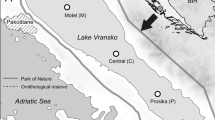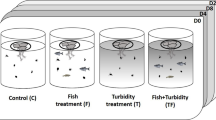Abstract
Phytoplankton dynamics in Lake Müggelsee, a eutrophic and polymictic lake in Berlin, and in the inflowing lowland River Spree have been comprehensively investigated during the last two decades. Zooplankton dynamics, nutrient supply, light climate, duration of ice cover and of summer stratification have also been regularly measured to help to explain phytoplankton development. The first period (1978–1990) was characterised by high nutrient loads and dominance of cyanobacteria from spring to autumn. Since then, loads of phosphorus and nitrogen have been lowered by 40–50%. Oscillatoria-like cyanobacteria (Limnothrix redekei, Planktothrix agardhii) were favoured under hypertrophic conditions in both the polymictic lake and the river, but they have disappeared nearly completely after nutrient reduction. Development of these species depended on meteorological conditions and nutrient supply in spring rather than on seasonal averages of nutrient concentrations. Diatoms have became dominant and chlorophytes have increased their share of the biomass since the nutrient load was reduced. Species com- position changed even within the algal groups. Retention time of water and duration of thermal stratification of the water column modified phytoplankton structure. Mobile algae like Microcystisor Ceratium occurred in the lake during stratification periods. Otherwise, species composition in the shallow, polymictic lake was very similar to that in the inflowing lowland river. Species with high starting biomass, fed by high riverine import, resting stages or perennation were selected in this flushed system.
Similar content being viewed by others
References
Anonymous, 1993. Deutsche Einheitsverfahren zur Wasser-, Abwasser-und Schlamm-Untersuchung, Verlag Chemie, Weilheim, 1.-28. Lieferung
Arndt, H., M. Krocker, B. Nixdorf & A. Köhler, 1993. Longterm annual and seasonal changes of meta-and protozooplankton in Lake Müggelsee (Berlin): effects of eutrophication, grazing activities and the impact of predation. Int. Rev. ges. Hydrobiol. 78: 379–402.
Behrendt, H. & B. Nixdorf, 1993. Changes of Secchi depth and seston content of the Lake Müggelsee since 1931-an example for eutrophication and feedbacks. ILEC conference, Stresa: 30–33.
Behrendt, H., B. Nixdorf & W. G. Pagenkopf, 1993. Phenomenological description of polymixis and influence on oxygen budget and phosphorus release in LakeMüggelsee. Int. Rev. ges. Hydrobiol. 78: 411–421.
Hamilton, P. B., 1990. The revised edition of a computerized plankton counter for phytoplankton, periphyton and diatom sediment analyses. Hydrobiologia 194: 23–30.
Hansson, L. A., 1996. Algal recruitment from lake sediments in relation to grazing, sinking and dominance patterns in the phytoplankton community. Limnol. Oceanogr. 41: 1312–1323.
Horgan, M. J. & E. L. Mills, 1997. Clearance rates and filtering activity of zebra mussel (Dreissena polymorpha): implications for freshwater lakes. Can. J. Fish. aquat. Sci. 54: 249–255.
Hutchinson, G. E., 1967. A Treatise on Limnology, John Wiley & Sons, New York: 1115 pp.
Jeppesen, E., P. Kristensen, J. P. Jensen, M. Sondergaard, E. Mortensen & T. Lauridsen, 1991. Recovery resilience following a reduction in external phosphorus loading of shallow, eutrophic danish lakes: duration, regulating factors and methods for overcoming resilience. Mem. Ist. ital. Idrobiol. 48: 127–148.
Kelly, M. G. & B. A. Whitton, 1998. Biological monitoring of eutrophication in rivers. Hydrobiologia 384: 55–67.
Köhler, J., 1994. Origin and succession of phytoplankton in a riverlake system (Spree, Germany). Hydrobiologia 289: 73–83.
Köhler, J. & S. Bosse, 1998. Growth and losses of phytoplankton studied with a new dialysis chamber technique along the river Spree. Arch. Hydrobiol. 142: 1–19.
Köhler, J. & B. Nixdorf, 1994. Influences of the lowland river Spree on phytoplankton dynamics in the flow-through Lake Müggelsee (Germany). Hydrobiologia 275/276 (Dev. Hydrobiol. 94): 187–195.
Köhler, J., B. Nixdorf & S. Hoeg, 1993. Lake Müggelsee and the in-flowing River Spree: comparison of phytoplankton communities 1980-1990. Int. Rev. ges. Hydrobiol. 78: 345–358.
Maasdam, R. & T. H. L. Claassen, 1998. Trends in water quality and algal growth in shallow Frisian lakes, The Netherlands. Wat. Sci. Technol. 37: 177–184.
Meffert, M. E., 1989. Planktic unsheathed filaments (Cyanophyceae) with polar and central gas vacuoles. II. Biology, population dynamics and biotopes of Limnothrix redekei (van Goor) Meffert. Arch. Hydrobiol. 116: 257–282.
Mur, L. R. & H. Schreurs, 1995. Light as a selective factor in the distribution of phytoplankton species. Wat. Sci. Technol. 32: 25–34.
Naumann, E., 1931, Limnologische Terminologie. In Abderhalden, E. (ed.), Handbuch der biologischen Arbeitsmethoden. Urban & Schwarzenberg, Berlin & Wien: 776 pp.
Nixdorf, B. & S. Hoeg, 1993. Phytoplankton-community structure, succession and chlorophyll content in LakeMüggelsee from 1979 to 1990. Int. Rev. ges. Hydrobiol. 78: 359–377.
Padisák, J. & C. S. Reynolds, 1998. Selection of phytoplankton associations in Lake Balaton, Hungary, in response to eutrophication and restoration measures, with special reference to the cyanoprokaryotes. Hydrobiologia 384: 41–53.
Reeders, H. H., P. C.M. Boers, D. T. Van der Molen & T. H. Helmerhorst, 1998. Cyanobacterial dominance in the lakes Veluwemeer and Wolderwijd, The Netherlands. Wat. Sci. Technol. 37: 85–92.
Reynolds, C. S., 1986. Experimental manipulations of the phytoplankton periodicity in large limnetic enclosures in Blelham Tarn, English Lake District. Hydrobiologia 138: 43–64.
Reynolds, C. S., 1988, Functional morphology and the adaptive strategies of freshwater phytoplankton. In Sandgren, C. D. (ed.), Growth and Reproductive Strategies of Freshwater Phytoplankton. University Press, Oxford: 388–433.
Reynolds, C. S., 1994. The long, the short and the stalled: on the attributes of phytoplankton selected by physical mixing in lakes and rivers. Hydrobiologia 289: 9–21.
Reynolds, C. S., 1997. Vegetation processes in the pelagic: a model for ecosystem theory, Excellence in Ecology, Ecology Institute, Oldendorf: 371 pp.
Reynolds, C. S. & J. P. Descy, 1996. The production, biomass and structure of phytoplankton in large rivers. Arch. Hydrobiol. Suppl. 113: 161–187.
Reynolds, C. S., M. L. White, R. T. Clarke & A. F. Marker, 1990. Suspension and settlement of particles in flowing water: comparison of the effects of varying water depth and velocity in circulating channels. Freshwater Biol. 24: 23–34.
Rodhe, W., 1948. Environmental requirements of fresh-water plankton algae. Symb. Bot. Upsal. 10: 5–149.
Sas, H. (ed.), 1989. Lake Restoration by Reduction of Nutrient Loading: Expectations, Experiences, Extrapolations. Academia Verlag Richarz, Sankt Augustin: 497 pp.
Scheffer, M., S. H. Hosper, M. L. Meijer, B. Moss & E. Jeppesen, 1993. Alternative equilibria in shallow lakes. Trends Ecol. Evol. 8: 275–279.
Scheffer, M., S. Rinaldi, A. Gragnani, L. R. Mur & E. H. Van Nes, 1997. On the dominance of filamentous cyanobacteria in shallow, turbid lakes. Ecology 78: 272–282.
Schindler, D. W., 1975. Whole-lake eutrophication experiments with phosphorus, nitrogen and carbon. Verh. int. Ver. Limnol. 19: 3221–3231.
Sommer, U., 1985. Comparison between steady state and nonsteady state competition: experiments with natural phytoplankton. Limnol. Oceanogr. 30: 335–346.
Thunmark, S., 1945. Zur Soziologie des Süßwasserplanktons. Folia limnol. Scand. 3: 5–66.
Tilman, D. & S. S. Kilham, 1976. Phosphate and silicate growth and uptake kinetics of the diatoms Asterionella formosa and Cyclotella meneghiniana in batch and semi-continuous culture. J. Phycol. 12: 375–383.
Utermöhl, H., 1958. Zur Vervollkommnung der quantitativen Phytoplankton-Methodik. Mitt. int. Ver. Limnol. 9: 1–38.
van Liere, L. & L. R. Mur, 1980, Occurrence of Oscillatoria agardhii and some related species, a survey. In Barica, J. & L. R. Mur (eds), Hypertrophic Ecosystems. Dr W. Junk Publishers, The Hague: 67–77.
Vollenweider, R. A. & J. Kerekes, 1980. OECD cooperative programme for monitoring of inland waters (eutrophication control), Synthesis report, Paris.
Author information
Authors and Affiliations
Rights and permissions
About this article
Cite this article
Köhler, J., Hoeg, S. Phytoplankton selection in a river–lake system during two decades of changing nutrient supply. Hydrobiologia 424, 13–24 (2000). https://doi.org/10.1023/A:1003988508599
Issue Date:
DOI: https://doi.org/10.1023/A:1003988508599




